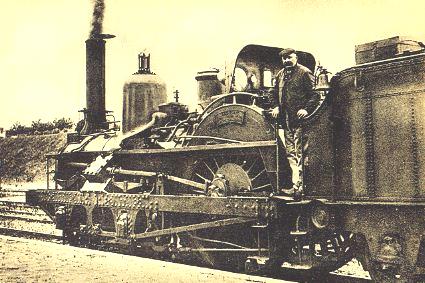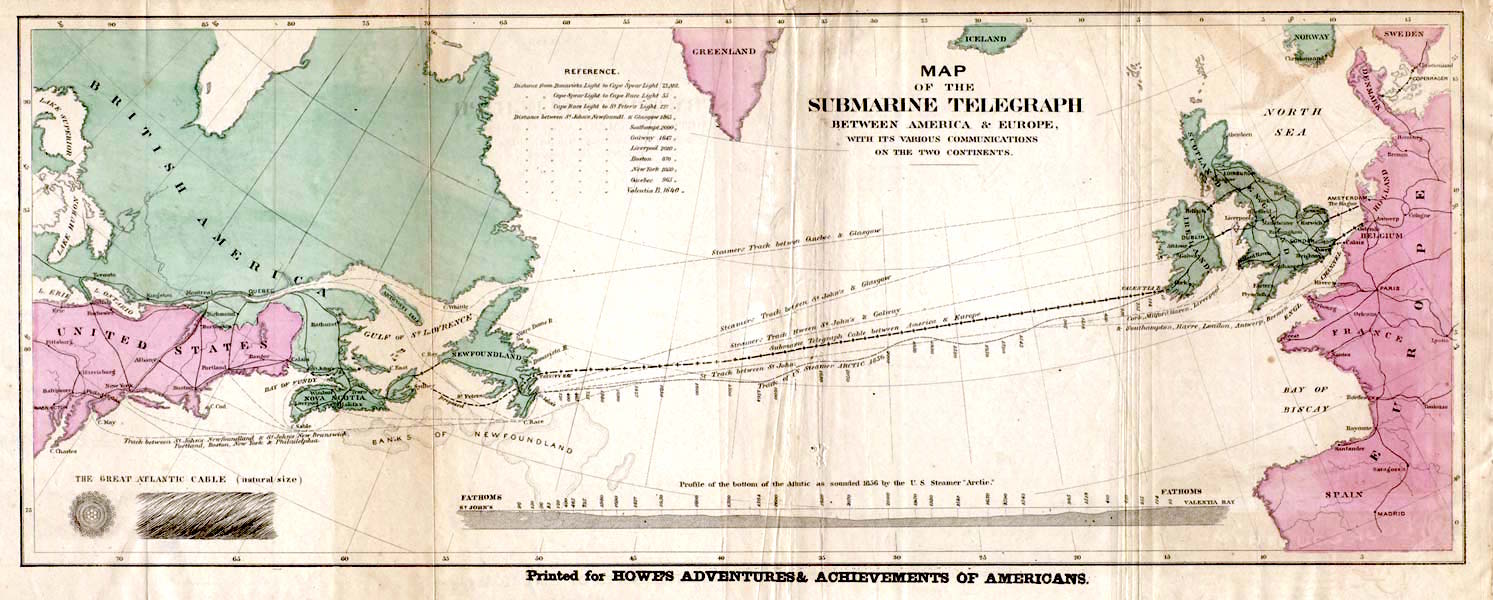|
Submarine Telegraph Company
The Submarine Telegraph Company was a British company which laid and operated submarine telegraph cables. Jacob and John Watkins Brett formed the English Channel Submarine Telegraph Company to lay the first cable across the English Channel. An unarmoured cable with gutta-percha insulation was laid in 1850. The recently introduced gutta-percha was the first thermoplastic material available to cable makers and was resistant to seawater. This first unarmoured cable was a failure and was soon broken either by a French fishing boat or by abrasion on the rocks off the French coast. The Bretts formed a new company, the Submarine Telegraph Company, and laid a new cable in 1851. This cable had multiple conductors and iron wire armouring. Telegraph communication with France was established for the first time in October of that year. This was the first undersea telegraph cable to be put in service anywhere in the world. The Company continued to lay, and operate, more cables between Engla ... [...More Info...] [...Related Items...] OR: [Wikipedia] [Google] [Baidu] |
Submarine Telegraph Cable
A submarine communications cable is a cable laid on the sea bed between land-based stations to carry telecommunication signals across stretches of ocean and sea. The first submarine communications cables laid beginning in the 1850s carried telegraphy traffic, establishing the first instant telecommunications links between continents, such as the first transatlantic telegraph cable which became operational on 16 August 1858. Subsequent generations of cables carried telephone traffic, then data communications traffic. Modern cables use optical fibre technology to carry digital data, which includes telephone, Internet and private data traffic. Modern cables are typically about in diameter and weigh around for the deep-sea sections which comprise the majority of the run, although larger and heavier cables are used for shallow-water sections near shore. Submarine cables first connected all the world's continents (except Antarctica) when Java was connected to Darwin, Northern Terri ... [...More Info...] [...Related Items...] OR: [Wikipedia] [Google] [Baidu] |
Greenwich
Greenwich ( , ,) is a town in south-east London, England, within the ceremonial county of Greater London. It is situated east-southeast of Charing Cross. Greenwich is notable for its maritime history and for giving its name to the Greenwich Meridian (0° longitude) and Greenwich Mean Time. The town became the site of a royal palace, the Palace of Placentia from the 15th century, and was the birthplace of many Tudors, including Henry VIII and Elizabeth I. The palace fell into disrepair during the English Civil War and was demolished to be replaced by the Royal Naval Hospital for Sailors, designed by Sir Christopher Wren and his assistant Nicholas Hawksmoor. These buildings became the Royal Naval College in 1873, and they remained a military education establishment until 1998 when they passed into the hands of the Greenwich Foundation. The historic rooms within these buildings remain open to the public; other buildings are used by University of Greenwich and Trinity Laban C ... [...More Info...] [...Related Items...] OR: [Wikipedia] [Google] [Baidu] |
Calais
Calais ( , , traditionally , ) is a port city in the Pas-de-Calais department, of which it is a subprefecture. Although Calais is by far the largest city in Pas-de-Calais, the department's prefecture is its third-largest city of Arras. The population of the city proper is 72,929; that of the urban area is 149,673 (2018).Comparateur de territoire: Aire d'attraction des villes 2020 de Calais (073), Commune de Calais (62193) INSEE Calais overlooks the Strait of Dover, the narrowest point in the |
Sangatte
Sangatte (; ) is a commune in the Pas-de-Calais department on the northern coast of France on the English Channel. The name is of Flemish origin, meaning hole or gap in the sand. Engineering Sangatte is the location for the Channel Tunnel's French cooling station, its British counterpart being at Samphire Hoe. In addition, it is the French end-point for the HVDC Cross-Channel, the connection between the UK and French electricity grids. History First underwater telegraph Sangatte was the landing point of the world's first operational underwater telegraph cable, laid across the Channel by the Submarine Telegraph Company in 1851 between South Foreland and Sangatte. Pioneering cross-Channel flight 'Blériot-Plage' is named to commemorate Louis Blériot who, on the July 25, 1909, was the first person to fly across the English Channel. He flew from the beach at Sangatte to the White Cliffs of Dover, to claim the prize offered by the Daily Mail. The crossing took 37 minutes in his a ... [...More Info...] [...Related Items...] OR: [Wikipedia] [Google] [Baidu] |
South Foreland
South Foreland is a chalk headland on the Kent coast of southeast England. It presents a bold cliff to the sea, and commands views over the Strait of Dover. It is centred northeast of Dover and 15 miles south of North Foreland. It includes the closest point on the Island of Britain to the European mainland at a distance of . This proximity gives it military significance and during the Second World War its coastal battery was built, along with a radar station. Lying between the busy Port of Dover and the remote and hazardous Goodwin Sands sandbank, its two lighthouses were important for navigation before their disuse. Much of the area is now owned by the National Trust and is open to the public; it is traversed by the Saxon Shore Way, the Kent coastal walk. Lighthouses Two lighthouses are on South Foreland: the lower light disused since 1910 and the upper light, a National Trust asset, disused since 1988. Geography and geology South Foreland marks the south-western limit ... [...More Info...] [...Related Items...] OR: [Wikipedia] [Google] [Baidu] |
Thames
The River Thames ( ), known alternatively in parts as the River Isis, is a river that flows through southern England including London. At , it is the longest river entirely in England and the second-longest in the United Kingdom, after the River Severn. The river rises at Thames Head in Gloucestershire, and flows into the North Sea near Tilbury, Essex and Gravesend, Kent, via the Thames Estuary. From the west it flows through Oxford (where it is sometimes called the Isis), Reading, Henley-on-Thames and Windsor. The Thames also drains the whole of Greater London. In August 2022, the source of the river moved five miles to beyond Somerford Keynes due to the heatwave in July 2022. The lower reaches of the river are called the Tideway, derived from its long tidal reach up to Teddington Lock. Its tidal section includes most of its London stretch and has a rise and fall of . From Oxford to the Estuary the Thames drops by 55 metres. Running through some of the drier parts of mai ... [...More Info...] [...Related Items...] OR: [Wikipedia] [Google] [Baidu] |
Submarine Cornhill 1852
A submarine (or sub) is a watercraft capable of independent operation underwater. It differs from a submersible, which has more limited underwater capability. The term is also sometimes used historically or colloquially to refer to remotely operated vehicles and robots, as well as medium-sized or smaller vessels, such as the midget submarine and the wet sub. Submarines are referred to as ''boats'' rather than ''ships'' irrespective of their size. Although experimental submarines had been built earlier, submarine design took off during the 19th century, and they were adopted by several navies. They were first widely used during World War I (1914–1918), and are now used in many navies, large and small. Military uses include attacking enemy surface ships (merchant and military) or other submarines, and for aircraft carrier protection, blockade running, nuclear deterrence, reconnaissance, conventional land attack (for example, using a cruise missile), and covert insertion of spec ... [...More Info...] [...Related Items...] OR: [Wikipedia] [Google] [Baidu] |
Thomas Russell Crampton
Thomas Russell Crampton, MICE, MIMechE (6 August 1816 – 19 April 1888) was an English engineer born at Broadstairs, Kent, and trained on Brunel's Great Western Railway. He is best known for designing the Crampton locomotive but had many engineering interests including the electric telegraph and the Channel Tunnel for which he designed a boring machine. His locomotives had much better success in France, Germany and Italy than they did in the UK. Personal life Born to John and Mary Crampton of Prospect Cottage (in what is now Dickens Walk), Broadstairs, on 6 August 1816, Crampton was the son of a plumber and architect. He was educated privately. Crampton married Louisa Martha Hall, who was a singer and a friend of Jenny Lind, on 25 February 1841. They had 8 children, six boys and two girls. The eldest girl, Ada Sarah, died aged 4 on 16 February 1857. and Crampton gifted a stained glass window in St. Peter's church, Broadstairs in her memory. Their youngest daughter, Louisa, wa ... [...More Info...] [...Related Items...] OR: [Wikipedia] [Google] [Baidu] |
Loading Coil
A loading coil or load coil is an inductor that is inserted into an electronic circuit to increase its inductance. The term originated in the 19th century for inductors used to prevent signal distortion in long-distance telegraph transmission cables. The term is also used for inductors in radio antennas, or between the antenna and its feedline, to make an electrically short antenna resonant at its operating frequency. The concept of loading coils was discovered by Oliver Heaviside in studying the problem of slow signalling speed of the first transatlantic telegraph cable in the 1860s. He concluded additional inductance was required to prevent amplitude and time delay distortion of the transmitted signal. The mathematical condition for distortion-free transmission is known as the Heaviside condition. Previous telegraph lines were overland or shorter and hence had less delay, and the need for extra inductance was not as great. Submarine communications cables are particularly sub ... [...More Info...] [...Related Items...] OR: [Wikipedia] [Google] [Baidu] |
Transatlantic Telegraph Cable
Transatlantic telegraph cables were undersea cables running under the Atlantic Ocean for telegraph communications. Telegraphy is now an obsolete form of communication, and the cables have long since been decommissioned, but telephone and data are still carried on other transatlantic telecommunications cables. The first cable was laid in the 1850s from Valentia Island off the west coast of Ireland to Bay of Bulls, Trinity Bay, Newfoundland. The first communications occurred on 16 August 1858, but the line speed was poor, and efforts to improve it caused the cable to fail after three weeks. The Atlantic Telegraph Company led by Cyrus West Field constructed the first transatlantic telegraph cable. The project began in 1854 and was completed in 1858. The cable functioned for only three weeks, but was the first such project to yield practical results. The first official telegram to pass between two continents was a letter of congratulations from Queen Victoria of the United ... [...More Info...] [...Related Items...] OR: [Wikipedia] [Google] [Baidu] |
Dispersion (optics)
In optics, and by analogy other branches of physics dealing with wave propagation, dispersion is the phenomenon in which the phase velocity of a wave depends on its frequency; sometimes the term chromatic dispersion is used for specificity to optics in particular. A medium having this common property may be termed a dispersive medium (plural ''dispersive media''). Although the term is used in the field of optics to describe light and other electromagnetic waves, dispersion in the same sense can apply to any sort of wave motion such as acoustic dispersion in the case of sound and seismic waves, and in gravity waves (ocean waves). Within optics, dispersion is a property of telecommunication signals along transmission lines (such as microwaves in coaxial cable) or the pulses of light in optical fiber. Physically, dispersion translates in a loss of kinetic energy through absorption. In optics, one important and familiar consequence of dispersion is the change in the angle of refra ... [...More Info...] [...Related Items...] OR: [Wikipedia] [Google] [Baidu] |








